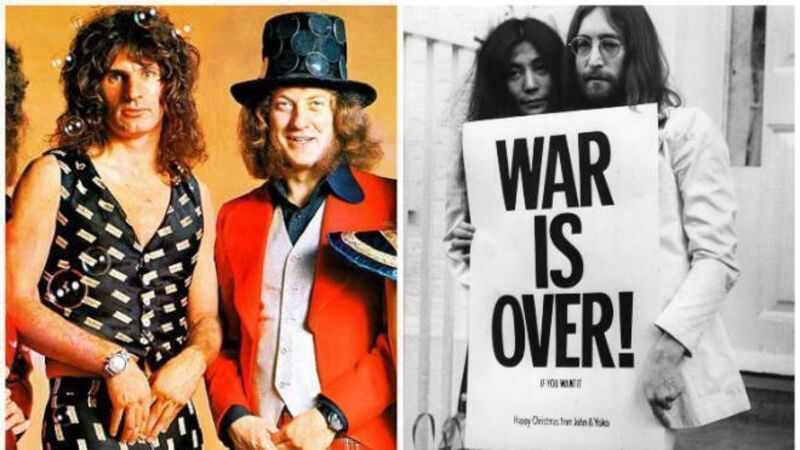Tom Dunne: So this is Christmas, and what's number one?

L-R: Slade, John Lennon (w/Yoko Ono) - two artists synoymous with the Christmas season
And so, this is Christmas. John Lennon: 43 years gone last week – it still upsets me – changed not only the course of popular music but wiped out the ‘novelty Christmas song’ market too.
Don’t mention his name around the Christmas trees of Alma Coogan or Gayla Peake. Not if you know what’s good for you.
Their respective Christmas hits, ‘You Should Never do a Tango with an Eskimo’ and ‘Hippopotamus for Christmas’, had fairly dominated the end of year Christmas charts.
Alma could sing “When a lady from Nebraska is at a party in Alaska”, knowing that silly as it was, it would put her kids through college.
Until Lennon got involved. Writing ‘Happy Christmas (War is Over)’ changed everything. A Beatle, of all things, was taking the Christmas song idea seriously. There was nothing novelty about ‘War is Over’. It was serious, of its time, post-Beatle and gorgeous. All bets were off.
Bands, real bands with real hits, suddenly thought that having a Christmas number one was a good thing to do. If it was good enough for a Beatle… ! Plans were made, studios booked, and unbeknownst to the general public a kind of Christmas songs arms race had begun.
Mud, a band it is impossible to know too little about, slipped into the number one slot in 1972, but it was a pyrrhic, phoney war victory. As 1973, in all its glam rock splendour played out, the two titans of the age squared up to each other. Twenty years before Blur vs Oasis, it was time for Wizard vs Slade.
Roy Wood’s Wizard – a more overblown version of ELO – had already had two number ones, with the ubiquitous ‘See My Baby Jive’ and its follow up ‘Angel Fingers’. They dressed like it was Christmas all year round, so their song, ‘I Wish it Could be Christmas Every Day’, looked a shoe-in.
But they hadn’t reckoned on Wolverhampton’s finest sons, the band Oasis could have been -the mercurial Slade. They’d already had three number ones, including ‘Cum on Feel the Noize’, the first song to go directly into the chart at number one since The Beatles’ ‘Get Back’ in 1969.
Slade’s ‘Merry Christmas Everybody’ was recorded in September 1973 at the Record Plant on 321 West 44th Street in New York. It comprised two previously-rejected tracks now hobbled together with a new lyric. John Lennon had recorded ‘Mind Games’ in that studio, and they “borrowed” his harmonium to fill out the sound.
It was a very one-sided battle. They outsold Wizard four to one and, despite only being on release for a month, it was still one of the biggest selling songs of the year.
But it was Slade’s appearance on the Top of the Pops Christmas Day special that really shook things up. That show was becoming as much an essential part of the Christmas season in the UK as Morecombe and Wise or Boxing Day soccer.
It was a huge audience, essentially in a one-day lockdown, with limited viewing options, full of food and drink and good cheer with an age span that ran the gamut of old and young alike. All tuned in to see who would be crowned king.
There were number ones and there was the Christmas Number one. Be number one on that day, and you seemed to own the year. Slade, resplendent in mirrored top hats and beery good cheer, appeared to have won 1973.
This created what you might call the happy time of Christmas number ones. When Queen topped the chart in 1975 with ‘Bohemian Rhapsody’ it looked as if all the year had been leading to this startling triumph. “Look on our works,” they seemed to say, “and despair.” Similarly Wings in 1977 with ‘Mull of Kintyre’ (“I haven’t gone away you know”), Boney M with ‘Mary’s Boy Child’ in 1978 (“We are silly, but God, do we need silly”), and Human League in 1981 with ‘Don’t You Want’ that seemed to say, “the future is here, and its wearing makeup.” ‘Feed the World’ in 1984 was a natural peak. Not only a great song but a caring one. We could look up from our Christmas dinners and feel we were doing something.
There have been great Christmas songs since – The Pogues obviously, Low’s Christmas album – but the era of it being the defining image of the year slipped away under the onslaught of a tsunami of viewing options.
Now it is Maria Carey and Ladbaby. John, please come back, we have need of you again.







